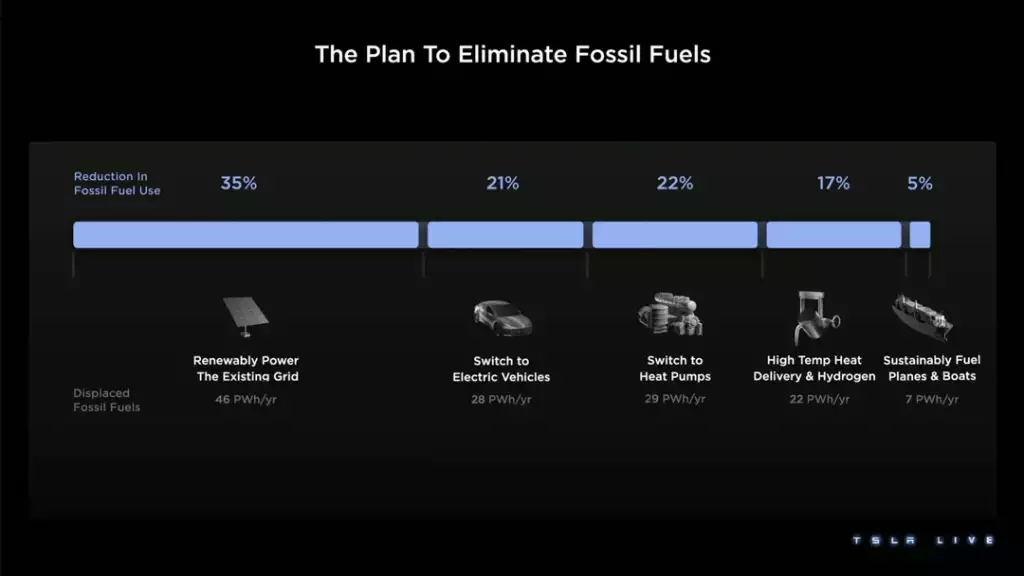During an investor event at Tesla’s Gigafactory in Austin, Texas, Elon Musk revealed the third part of the company’s “Master Plan”. The plan entails leading a worldwide effort to eliminate fossil fuels and transition to sustainable energy. The initiative involves augmenting the existing grid with renewable energy, producing additional electric vehicles, installing heat pumps in buildings and homes, implementing high-temperature heat delivery and hydrogen for industrial applications, and constructing planes and boats that are fueled sustainably. The ultimate objective of Musk’s Master Plan 3 is to establish a “sustainable energy civilization.”
According to Tesla, a $10 trillion investment is necessary to achieve a sustainable future powered by renewable energy. Musk emphasized that this amount is not significant when compared to the global economy. Musk stated, “There is a clear path to sustainable energy on Earth. It doesn’t require destroying natural habitats. It doesn’t require us to be austere, stop using electricity, and be in the cold or anything.”
Expanding the world’s energy storage capacity by up to 240TWh is a critical aspect of realizing this vision. According to Tesla executives at the event, this can be achieved without the requirement of significant ore mining. Musk stated that it would only necessitate less than 30% of the Earth’s total nickel supply, and iron would also be required, but he is not worried since it is the most plentiful metal on the planet.

Image Source: Tesla
Musk also stated that the necessary infrastructure, including wind and solar, would occupy “less than 0.2 per cent” of the Earth’s surface. However, the specifics on how this will be accomplished are still vague, but Musk assured that a white paper detailing the plan would be released shortly.
“I wanted today to be not just about Tesla investors who own stock, but anyone who is an investor in Earth,” said Musk, expressing his optimism. Despite its nearly three-hour duration, the event did not divulge any specific information about new vehicles. However, the company did provide a glimpse of two undisclosed vehicles through presentation images – one resembling a smaller car, and the other reaching a small commercial truck.
There was no mention of Musk’s other ventures, SpaceX and The Boring Company, despite his prior insinuations that the third Master Plan would connect his various businesses. Tesla showcased a more efficient vehicle manufacturing process called the “Unboxed Process,” which will be implemented in its next generation of vehicles. The process involves building the vehicle once on the assembly line and only painting the necessary parts. Additionally, the automaker asserts that the next-gen drive unit will not use any rare earth minerals. Tesla’s past two master plans have been a mixed bag. Although the first plan, published in 2006, achieved most of its objectives, the second plan has yet to be realized to a significant extent.
The plan, which was published in 2016 under the playful title “Part Deux,” outlined Tesla’s intent to establish a prosperous solar business, unveil several new vehicles across all significant categories, attain full autonomy, and introduce a robotaxi network enabling vehicle owners to earn up to $30,000 yearly. Although Tesla has launched its solar roof division, installations have been sluggish, and some customers have voiced grievances about significant price increases. Furthermore, as revenues remain relatively stagnant, the company has dialled back its aspirations.
Since publishing its second Master Plan, Tesla has introduced two new vehicles: the Tesla Semi and the Cybertruck. Late last year, Tesla began delivering the Tesla Semi, and the Cybertruck is still planned for release later this year, according to Tesla lead designer Franz von Holzhausen, who was onstage at the event. Musk has stated that mass production of the oddly designed truck would begin in 2024.
However, Tesla’s plans for fully autonomous vehicles are uncertain. While AV operators like Waymo and Cruise have fully driverless robotaxis, Tesla has taken a different approach by offering a $15,000 option called Full Self-Driving (FSD) to hundreds of thousands of customers. Despite the misleading name, FSD is only a Level 2 partially autonomous system that requires constant monitoring by the driver. After the National Highway Traffic Safety Administration called it a “crash risk,” Tesla recently paused new installations of FSD.
Musk’s original promise that Tesla owners with FSD could earn passive income by using their vehicles as a robotaxi service has yet to be fulfilled. Recently, Musk has hinted that Tesla would produce a standalone robotaxi vehicle, raising questions about whether Teslas currently on the road would qualify for the service as initially proposed.

